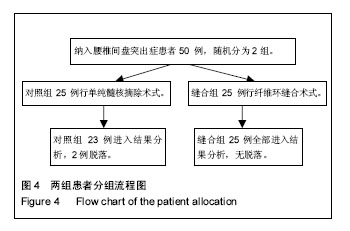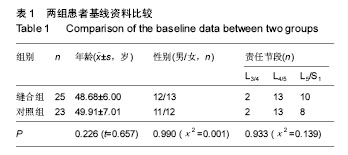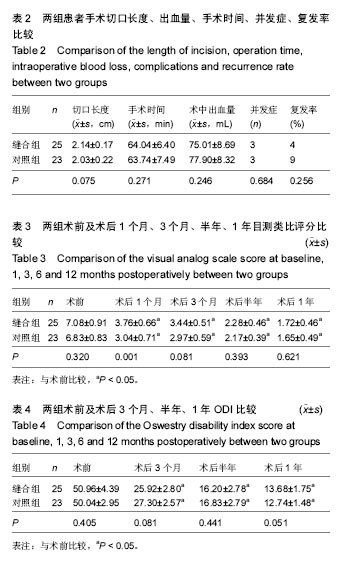| [1] 尹德龙,程鹏,范震波,等.早期干预对腰椎间盘突出症的影响—多中心大样本量随访[J].中国矫形外科杂志, 2014, 22(13):1153-1157.[2] 徐奎,覃正仕,赵权.腰椎间盘突出症微创治疗研究进展[J]. 现代中西医结合杂志, 2016, 25(1):109-112.[3] 胡袒,郑超,伍骥,等.内窥镜下椎间盘切除术治疗腰椎间盘突出症术后复发的影响因素分析[J]. 中国脊柱脊髓杂志, 2015, 25(10): 899-903.[4] 俞鹏飞,姜宏,刘锦涛,等.破裂型腰椎间盘突出症非手术治疗后的转归[J]. 中国脊柱脊髓杂志, 2015, 25(2):109-114.[5] 李德亨,蔡丰,刘亮,等. 旁正中入路TLIF联合单侧椎弓根螺钉内固定治疗青壮年腰椎间盘突出症的中期临床疗效分析[J]. 中国矫形外科杂志, 2015, 23(13):1163-1168.[6] Johannes LB, Marco NH, Hans JM, et al. Repair,regenerative and supportive therapies of the annulus fibrosus: achievements and challenges. Eur Spine J. 2009;18(3):301-313.[7] 何斌,沈皆亮,许圣茜,等. SDF-1/CXCR4信号轴促进退变椎间盘胞外基质降解的研究[J]. 中国矫形外科杂志, 2017, 25(5):452-458.[8] Chiang CJ, Cheng CK, Sun JS, et al. The effect of a new anular repair after discectomy in intervertebral disc degeneration: an experimental study using a porcine spine model[J]. Spine(Phila Pa 1976). 2011; 36(10): 761-769. [9] 张兆川,姜效韦,戴维享,等. Waveflex弹性固定与髓核摘除纤维环修复重建腰椎间盘突出患者脊柱稳定性[J]. 中国组织工程研究, 2015, 19(44):7131-7136.[10] Bouma GJ, Barth M, Ledic D, et al. The high-risk discectomy patient: prevention of reherniation inpatients with large anular defects using an anular closure device. Eur Spine J.2013; 22(5):1030-1036.[11] Bang SH, Gyu YJ, Bongju M, et al. Use of Annular closure device(Barricaid®)for preventing lumbar disc reherniation: one-year results of three cases. Korean J Neurotrauma. 2014;10(2):119-122.[12] Izci Y. Anular closure device: is it necessary after discectomy? Eur Spine J. 2014;23(2):483-484.[13] Bailey A, Araghi A, Blumenthal S, et al. Prospective, multicenter,randomized, controlled study of anular repair in lumbar discectomy: two-year follow-up.Spine(Phila Pa 1976). 2013;38(14):1161-1169. [14] Zhang Y,Chee A, Thonar EJ,et al.Intervertebral disk repair by Protein,Gene, or Cell Injection: a framework for rehabilitation- focused biologics in the spine. PM R. 2011; 3(6):S88-S94.[15] Clare CG,Eugene YS,Sebastien BG, et al. Challenges and strategies in the repair of ruptured annulus fibrosus. Eur Cell Mater. 2013;2(25):1-21.[16] 徐建彪,张伟学,王鸿晨,等.微创与开放椎间盘切除术治疗腰椎椎间盘突出症的Meta分析[J].脊柱外科杂志, 2017, 15(1):39-45.[17] 王志荣,陆爱清,杨惠林,等. Quadrant通道下TLIF术治疗复发性腰椎间盘突出症的疗效分析[J]. 中国脊柱脊髓杂志, 2014, 24(2): 121-126.[18] 高金伟,梁伟之,常甲楠. 后路环形减压治疗高位腰椎间盘突出症临床疗效观察[J]. 中国骨与关节损伤杂志, 2014,30(s1):5-6.[19] 冯皓宇, 马迅, 何李明,等. 后路椎间植骨融合与椎弓根钉内固定修复复发性腰椎间盘突出症:6个月随访[J]. 中国组织工程研究, 2015, 19(9):1371-1376.[20] 田胜兰,谭伟,冯丹,等.经皮椎间孔镜下髓核摘除术治疗腰椎间盘突出症的临床观察[J]. 华中科技大学学报医学版, 2015,44(4): 472-475.[21] 张之栋,杜怡斌,储建军.经皮椎间孔镜腰椎间盘摘除术与微创经椎间孔腰椎融合术治疗腰椎间盘突出症的前瞻性随机对照研究[J]. 中国微创外科杂志, 2015,15(7):583-587.[22] 王翀,田征,梁青福,等.经皮椎间孔镜TESSYS技术治疗单节段腰椎间盘突出症60例分析[J].中国内镜杂志, 2016, 22(1):32-36.[23] 杨洋,尹晓红,余将明,等.纤维环缝合对腰椎稳定性及椎间盘内压力影响的研究[J]. 中国矫形外科杂志,2014,22(13) :1217-1220. [24] Suh BG,Uh JH,Park SH,et al. Repair using conventional implant for ruptured annulus fibrosus after lumbar discectomy:surgical technique and case series. Asian Spine J. 2015,9(1) :14-21.[25] 何勍,王德利,张超,等.椎间盘镜与椎板开窗治疗单节段腰椎间盘突出症疗效对比分析[J]. 中国矫形外科杂志, 2008;16(7):510-512.[26] 付海祥, 曹兴兵, 陈奇,等.腰椎间盘突出症融合术后邻近节段退变危险因素[J].中国矫形外科杂志, 2015, 23(13):1179-1182.[27] 任佳彬,刘鹏飞,孙兆忠,等. 椎间孔镜术与传统椎板间开窗术治疗青少年腰椎间盘突出症的比较研究[J]. 中国矫形外科杂志, 2015, 23(21):1938-1942.[28] 许国华,贾连顺,李家顺,等.腰椎间盘突出症再手术临床分析[J]. 中国矫形外科杂志, 2002,10(13):1342[29] 沙吾提江•卡斯木,黄卫民,努尔买买提•巴哈夏尔,等.两种术式治疗腰椎间盘突出症的解剖学研究及疗效对比[J].中国矫形外科杂志, 2015, 23(1):41-46.[30] 杨洋,叶晓健,杨成伟,等.腰椎间盘纤维环切口不同修复方法的生物力学研究[J].中国脊柱脊髓杂志,2014,24(7):626-629. [31] Park Y ,Ha JW,Lee YT,et al. Minimally invasive transforaminal lumbar interbody fusion for spondylolisthesis and degenerative spondylosis:5-Year results.Clin Orthop Relat Res.2014; 472(6):1813-1823.[32] Wang H,Huang B,Li C,et al.Learning curve for percutaneous endoscopic lumbar discectomy depending on the surgeon's training level of minimally invasive spine surgery.Clin Neurol Neurosurg. 2013;115(10):1987-1991. [33] 刘彦斌,付强.后路Isobar非融合内固定系统修复腰椎间盘突出症:恢复腰椎活动度更具优势[J]. 中国组织工程研究, 2015, 19(13): 2051-2056.[34] Arts MP, Kols NI, Onderwater SM, et al. Clinical outcome of instrumented fusion for the treatment of failed back surgery syndrome: a case series of 100 patients.Acta Neurochir(Wien). 2012;154(7):1213-1217.[35] 张翊,任忠明,张玉良,等.经皮椎间盘镜与传统开窗髓核摘除术治疗腰椎间盘突出症疗效比较[J]. 临床骨科杂志, 2015,18(2): 163-166.[36] Bartlett A,Wales L,Houfburg R,et al.Optimizing the effectiveness of a mechanical suture-based anulus fibrosus repair construct in an acute failure laboratory Simulation.J Spinal Disord Tech. 2013;26(7):393-399. [37] Kepler CK, Anderson DG, Tannoury C,et al.Intervertebral disk degeneration and emerging biologic treatments.J Am Acad Orthop Surg. 2011;19(9):543-553. |
.jpg)



.jpg)
.jpg)
.jpg)
.jpg)